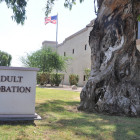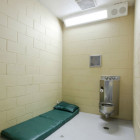
Vera Institute of Justice: Community Corrections Can Answer Mass Incarceration Problems
|
Community supervision aimed at high-risk offenders, as well as mandatory evidence-based programs, have the potential to curtail the U.S. correctional system.
Juvenile Justice Information Exchange (https://jjie.org/tag/the-chicago-bureau/)

Community supervision aimed at high-risk offenders, as well as mandatory evidence-based programs, have the potential to curtail the U.S. correctional system.

Originally appeared in The Chicago Bureau
CHICAGO - Violence stalks Chicago’s streets, but when faced with staunchly rising homicide rates that show no sign of ebbing, residents’ capacity to tolerate the state of crime drains by the day. After Hadiya Pendleton performed with her high school marching band during the presidential inauguration two weeks ago, the King College Prep teen became Chicago’s 42nd homicide victim of 2013 when she was gunned down on Chicago’s South Side – the unintended victim of a gang dispute. Her death added to a January homicide toll that was the bloodiest since 2002, according to Chicago Police reports, suggesting that despite wide attention to Chicago’s murder woes, shifts in policing strategy and big promises by powerful politicians, there will be no immediate respite to the escalating violence that claimed more than 500 in 2012. The ups and downs of Chicago’s homicide toll over the past six years/Graphic by Lynne Carty/The Chicago Bureau
Perhaps it’s because Pendleton performed for Obama, or maybe because she starred in an anti-gang public service announcement four years ago (Pendleton PSA) pleading for an end to the chaos, but the nation has embraced this 15-year-old as a symbol and not just another statistic. As for those who study crime, who write about it and opine about it in Chicago, the nation’s murder capital, the question remains whether it will really matter:
“There is action because of the attention but it is not clear that it will work,” said University of Illinois at Chicago’s Dick Simpson, a known political expert and former alderman who recently studied the nexus of drugs, gangs and police corruption.

This story produced by the Chicago Bureau. The close of 2012 focused so narrowly on terrible events and startling numbers - the Newtown massacre, for example, or Chicago’s sharp rise in homicides - some major criminal justice developments were nearly squeezed out of the national conversation. Take the statements made just over a week ago by Cook County Board President Toni Preckwinkle, who vowed to take on the tricky issue of the skewed racial picture in the county’s corrections and justice system, including within the juvenile justice system. Speaking to a group of reporters, the news – including a statement that she will “work with the actors in the public safety arena” to lessen the overall corrections population and push alternatives to locking up non-violent offenders – the story got little more than a day’s play on the airwaves and in other media. Always outspoken, the board president served many years as an alderman fighting for various social justice causes, including race and drug issues (she at one point challenged the validity of any national “war on drugs”).

Ambitious and certain to draw criticism, President Barack Obama’s plan to rid the nation of the most powerful weapons on the market and attempt to arrest mass and everyday shootings was expected by Congress Wednesday, marking a sharp turn in a decades-long fight to curb America’s gun violence. As the debate was playing out in Washington, several local and national leaders gathered at the University of Chicago Tuesday evening to discuss guns and policy, with Chicago Mayor Rahm Emanuel, whose city holds the dubious “murder capital” title, among the group and pushing sweeping gun control legislation that cracks down on assault weapons. Also on the panel was Democratic political consultant David Axelrod, who this week said that the National Rifle Association’s recent assertion that Congress would not enact the sort of change that Obama and others were pressing, was off base. In fact, he said, real legislation will squeeze through the legislative process and signal real change in the nation’s laws and gun dialogue. Also in attendance was the head of the University of Chicago CrimeLab, who noted that while the United States has managed to improve its count of more common crime – property theft, etc.

Four women stood at the front of a room, speaking before the small crowd with strong voices even though each had gone through a harrowing and emotional experience. The women – Joyce Ann Brown, Audrey Edmunds, Tabitha Pollock and Gloria Goodwin-Killian – had all been wrongfully convicted and imprisoned for crimes they did not commit. In total, they spent 45 years incarcerated, knowing all the while they were innocent and clinging to some hope that this fact would come to light. Now free, thanks in no small part to innocence projects around the nation, their testimonies before the crowd headlined the commencement of the Women’s Project at the Northwestern University law school’s Center on Wrongful Convictions this month. “In the Center’s 13 year history, we’ve represented four women, all of whom were accused and wrongfully convicted of the murders of their children,” said Karen Daniel, a co-director of the Women’s Project and a professor at Northwestern University.

CHICAGO -- Even as national organizations rallied this week to end solitary confinement for incarcerated juveniles across the country, the local branch of American Civil Liberties Union is working with prison officials and the federal court to focus on the issue here. The goal: settle a lawsuit on behalf of 2,217 incarcerated youth with the Illinois Department of Juvenile Corrections over the system’s inadequate services and often-hostile environment. A preliminary agreement calls for curbing the growing practice of solitary confinement in youth centers, which activists say constitutes “torture,” given its potential for causing long-lasting psychological harm. The proposed settlement, which is due for a fairness hearing in federal court in Chicago on December 6, would be the latest victory in a larger movement to end the punitive isolation of youth in custody. In June, Congress held its first hearing on the issue of solitary confinement within U.S. prisons, where roughly 80,000 inmates are in “restricted housing“ at any given time nationwide, according to a 2005 census of adult inmates by the federal Bureau of Justice Statistics.

Almost five years ago, Missourian Tracy McClard’s 17-year-old son, Jonathan, was tried, convicted and sentenced as an adult for a shooting that seriously wounded the victim. While incarcerated in an adult prison, Tracy McClard said, her son suffered from abuse, depression, and ultimately took his own life. McClard, who said she believes all kids deserve a second chance, created the National Youth Justice Awareness month where non-profits, community organizations and families would gather to raise awareness about how youth are treated in the adult system. In October – which McClard is hoping will turn into a nationally recognized month to assist juvenile offenders – there will be various events to mark the effort. There will be, among other things, service days, 5K walks and film screenings across 20 states in the country to generate support and, backers hope, give speed to recent gains made by juvenile advocates.

By Audrey Cheng and Jennifer Starrs
Emotions and rhertoric have been running high as CTU teachers and paraprofessionals formed picket lines, beginning early Monday and continuing Wednesday with no quick end in sight for the first schools strike since 1987. Teachers are pushing for a contract, better working conditions and more social workers in schools, amomg other issues – while administration officials are pressing for big curricular and testing changes, including a greater emphasis on programs like charter schools.
Audrey Cheng and Jennifer Starrs are reporters for The Chicago Bureau.

By Natalie Krebs and Lorraine Ma
CHICAGO -- It was rare news in a summer filled with frightening crime statistics, equally alarming headlines and a mayor and police superintendent on the defensive: For the month of July, killings in this city were down 11 percent from the same period last year, with the number of homicides for the month at 49. But such news matters little to people like Shirley Askew, who grew up on Chicago’s West Side, whiling away days playing in the streets and city parks. And it means little when the overall homicide rate for the year is still up nearly 27 percent. Many children are scared; they’re kept indoors, and, in a very real sense, locked out of their childhoods. Now 59, with four sons and four grandsons, Askew indeed worries about the increasing neighborhood violence that threatens local children’s safety. Just Thursday afternoon, not far from where Askew spoke with reporters, two 16-year-old boys were gunned down and another wounded.

CHICAGO - After the Williams Institute, True Colors Fund and the Palette Fund released a critical study on LGBT youth homelessness last month, Chicago-based experts have weighed in and offered reaction to the study's findings that 40 percent of homeless youth identify as Lesbian, Gay, Bisexual, and Transgender and many agencies designed to meet their needs have failed to adequately address pressing concerns. The study, conducted between October 2011 and March 2012, was designed to assess how homeless youth organizations provide services to LGBT youth. (See related story)
About 380 respondents from 354 agencies that serve homeless youth participated in the web-based survey. Overall, the study found that the current network of homeless youth providers “is not adequately addressing the needs of gay and transgender homeless youth,” according to the Chicago Coalition for the Homeless. The survey showed about 30 percent of homeless using housing-related services—emergency shelters and transitional living programs—were LGBT.